The Intel Xeon W-3175X Review: 28 Unlocked Cores, $2999
by Ian Cutress on January 30, 2019 9:00 AM ESTCPU Performance: Rendering Tests
Rendering is often a key target for processor workloads, lending itself to a professional environment. It comes in different formats as well, from 3D rendering through rasterization, such as games, or by ray tracing, and invokes the ability of the software to manage meshes, textures, collisions, aliasing, physics (in animations), and discarding unnecessary work. Most renderers offer CPU code paths, while a few use GPUs and select environments use FPGAs or dedicated ASICs. For big studios however, CPUs are still the hardware of choice.
All of our benchmark results can also be found in our benchmark engine, Bench.
For our graphs, some of them have two values: a regular value in orange, and one in red called 'Intel Spec'. ASUS offers the option to 'open up' the power and current limits of the chip, so the CPU is still running at the same frequency but is not throttled. Despite Intel saying that they recommend 'Intel Spec', the system they sent to us to test was actually set up with the power limits opened up, and the results they provided for us to compare to internally also correlated with that setting. As a result, we're providing both sets results for our CPU tests.
Corona 1.3: Performance Render
An advanced performance based renderer for software such as 3ds Max and Cinema 4D, the Corona benchmark renders a generated scene as a standard under its 1.3 software version. Normally the GUI implementation of the benchmark shows the scene being built, and allows the user to upload the result as a ‘time to complete’.
We got in contact with the developer who gave us a command line version of the benchmark that does a direct output of results. Rather than reporting time, we report the average number of rays per second across six runs, as the performance scaling of a result per unit time is typically visually easier to understand.
The Corona benchmark website can be found at https://corona-renderer.com/benchmark
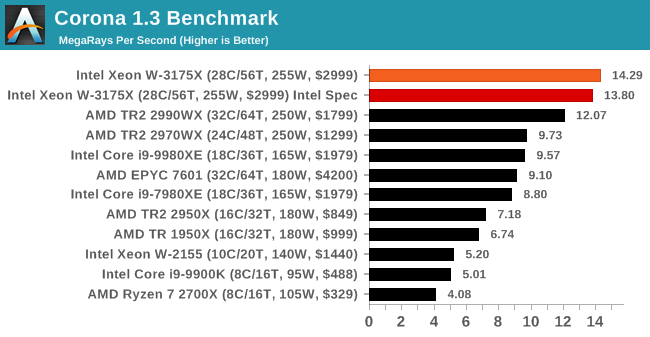
.
Blender 2.79b: 3D Creation Suite
A high profile rendering tool, Blender is open-source allowing for massive amounts of configurability, and is used by a number of high-profile animation studios worldwide. The organization recently released a Blender benchmark package, a couple of weeks after we had narrowed our Blender test for our new suite, however their test can take over an hour. For our results, we run one of the sub-tests in that suite through the command line - a standard ‘bmw27’ scene in CPU only mode, and measure the time to complete the render.
Blender can be downloaded at https://www.blender.org/download/
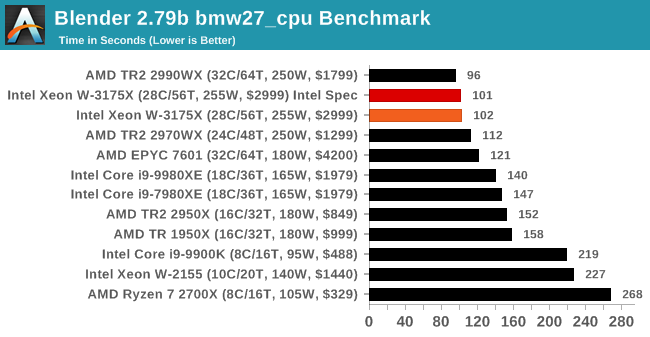
.
LuxMark v3.1: LuxRender via Different Code Paths
As stated at the top, there are many different ways to process rendering data: CPU, GPU, Accelerator, and others. On top of that, there are many frameworks and APIs in which to program, depending on how the software will be used. LuxMark, a benchmark developed using the LuxRender engine, offers several different scenes and APIs.
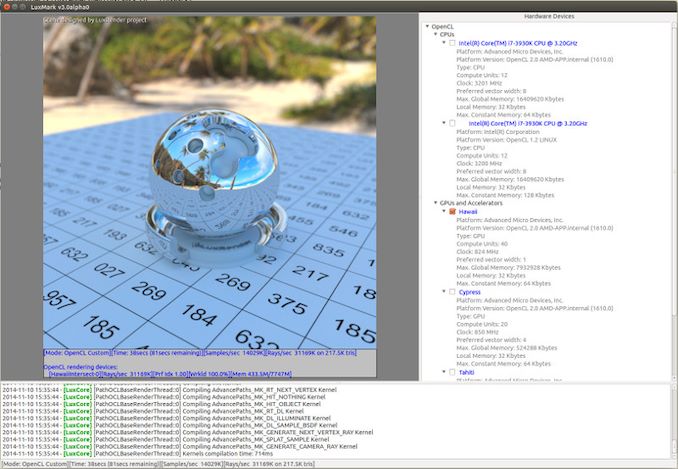
Taken from the Linux Version of LuxMark
In our test, we run the simple ‘Ball’ scene on both the C++ and OpenCL code paths, but in CPU mode. This scene starts with a rough render and slowly improves the quality over two minutes, giving a final result in what is essentially an average ‘kilorays per second’.
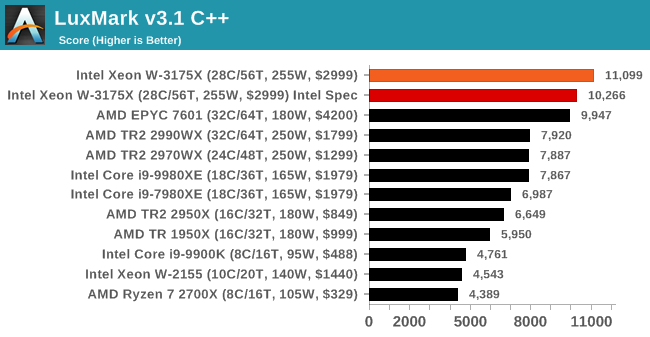
.
POV-Ray 3.7.1: Ray Tracing
The Persistence of Vision ray tracing engine is another well-known benchmarking tool, which was in a state of relative hibernation until AMD released its Zen processors, to which suddenly both Intel and AMD were submitting code to the main branch of the open source project. For our test, we use the built-in benchmark for all-cores, called from the command line.
POV-Ray can be downloaded from http://www.povray.org/
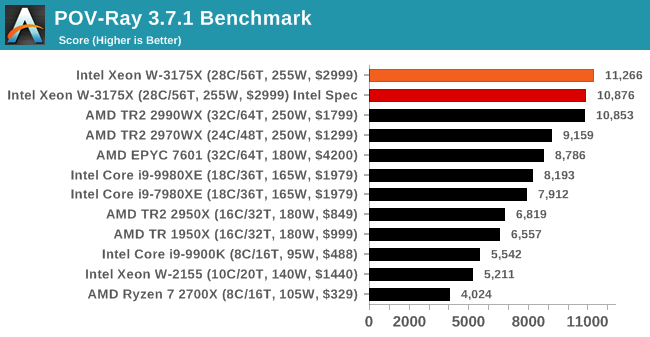
.











136 Comments
View All Comments
Madvocal1 - Monday, February 4, 2019 - link
Ian and readers, The ASUS ROG motherboard looks great the Intel 28 cores seem like a beast to, your scores might be way better if you contact ASUS and have them help you because you sound confused on what to set in BIOS and how to run high end system correctly.MikeV8 - Wednesday, February 6, 2019 - link
3175X Intel’s biggest chip ever? Not really. You're missing it's predecessor from 1995 - the legendary Pentium Pro for Socket 8, which is even bigger that the Threadripper. Or maybe you're too young to remember even the Pentium II Xeon which superseded Pentium Pro in 1998.Ah, I miss good old days with Anand Lal Shimpi.
MackerVII - Tuesday, March 19, 2019 - link
I'm sure someone mentioned this already....Everyone is complaining so much about how expensive this processor is but I have two points to mention.
- It's pretty much the same as Intel's top Xeon the 8180 which is a $10,000 processor.
- AMD's processor is basically a fake, 4 processors in one (and I love AMD).
So now a consumer can buy Intel's best Server processor for $7,000 less.
ADVenturePO - Saturday, May 4, 2019 - link
Well, this is heavy price. Maybe fair, but availability is a madness. But taking in account LC i9--7980XE is the best here. It kills competition with speeds. On LC it can be clocked after precise regulation of voltages up to 4.8GHz and up to 4.7GHz with 128GB of 3200MHz RAM.I'm selling stations like that. Easy to build, easy to run, easy to cool. MBs at stock.
That chip is just a showoff .
urbanman2004 - Saturday, May 18, 2019 - link
AMD's "EPYC" is gonna cause Intel a epic faileqlrutaoyqsm - Tuesday, August 25, 2020 - link
http://bitly.com/zoom-viber-skype-psy